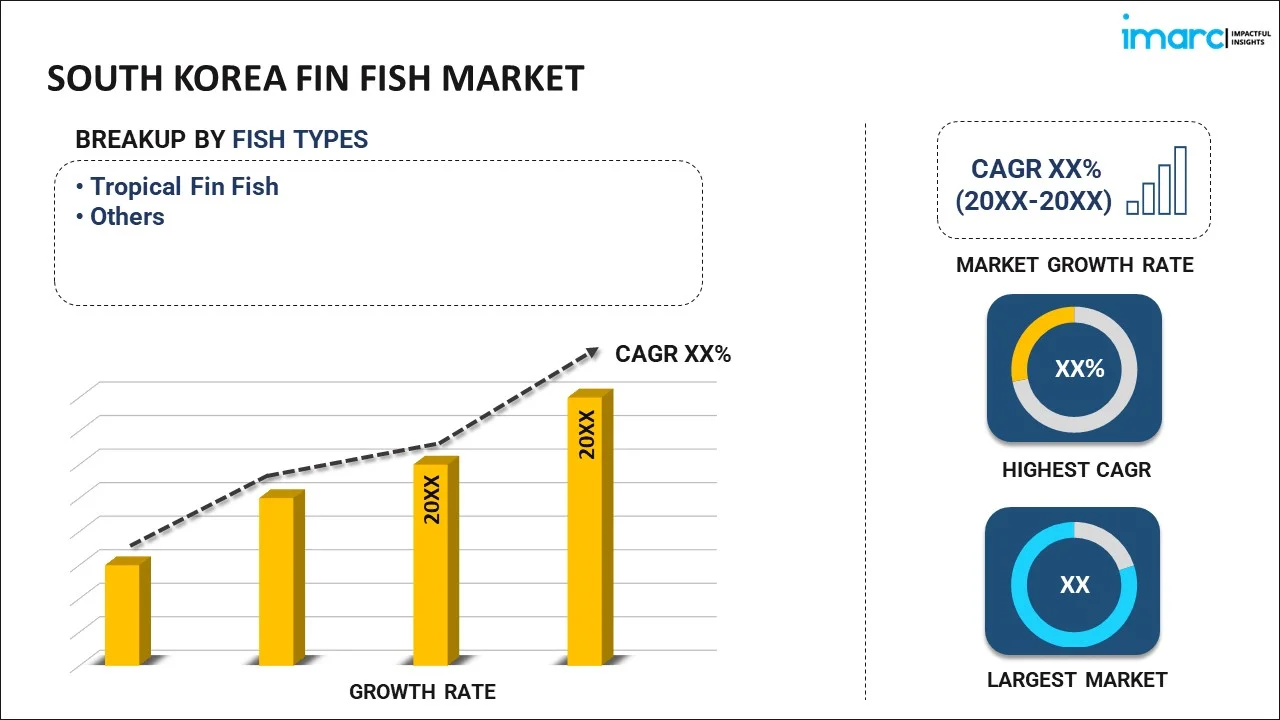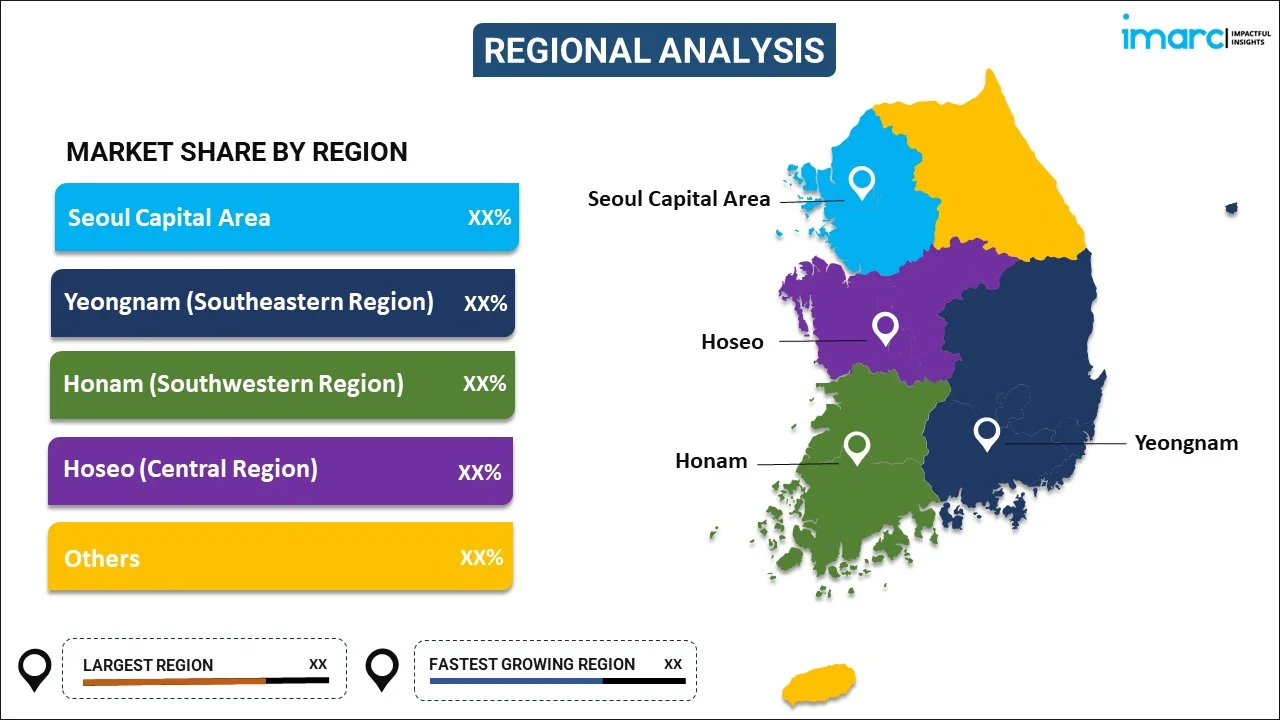
South Korea Fin Fish Market Report by Fish Type (Tropical Fin Fish, and Others), Environment (Freshwater, Marine Water, Brackish Water), Distribution Channel (Supermarkets and Hypermarkets, Convenience Stores, Specialty Stores, Online Stores, and Others), and Region 2025-2033
Market Overview:
South Korea fin fish market size is projected to exhibit a growth rate (CAGR) of 4.77% during 2025-2033. The increasing health awareness, cultural dietary habits, sustainable sourcing initiatives, government support for aquaculture, advancements in technology, demand for premium-quality seafood, and globalization of culinary preferences represent some of the key factors driving the market.
|
Report Attribute
|
Key Statistics
|
|---|---|
|
Base Year
|
2024 |
|
Forecast Years
|
2025-2033 |
|
Historical Years
|
2019-2024
|
| Market Growth Rate (2025-2033) | 4.77% |
Fin fish, also known as teleost fish, are a diverse group of vertebrates characterized by the presence of fins and scales that contribute to their locomotion and stability in water. This group comprises a vast array of species found in both freshwater and marine environments, ranging from familiar varieties like salmon and tuna to lesser-known species inhabiting various ecosystems worldwide. Fin fish play a crucial role in aquatic ecosystems, contributing to biodiversity while also serving as a significant food source for humans. These fish are a valuable protein source and a staple in many diets globally. They are harvested through commercial fishing and aquaculture, contributing to the economies of coastal regions and meeting the dietary needs of millions of people.
South Korea Fin Fish Market Trends:
The rising awareness of the health benefits associated with fish consumption has led to an increased demand for fin fish as a source of lean protein and essential omega-3 fatty acids, primarily driving the market growth. Besides this, the rising influence of cultural dietary habits, where fish is staple in Korean cuisine, has maintained a consistent demand for a variety of fin fish species, creating a favorable outlook for market expansion. Moreover, the growing focus on sustainable and responsible seafood sourcing, prompting consumers and businesses to support fisheries and aquaculture practices that prioritize environmental stewardship and conservation, is strengthening the market growth. In confluence with this, favorable government initiatives and policies promoting the expansion of the aquaculture industry in South Korea have contributed to increased production and availability of domestically produced fin fish, supporting the market expansion. Concurrently, ongoing advancements in aquaculture technology and practices enhancing the efficiency and productivity of fish farming operations are presenting lucrative opportunities for market expansion. Besides this, continuous improvements in cold chain logistics and distribution networks facilitating the transportation of fin fish over longer distances and connecting producers with a broader consumer base are propelling the market forward. Additionally, the rising trend of health-conscious consumerism leading to an increased preference for organic and premium-quality fin fish is providing an impetus to the market growth. Furthermore, the globalization of culinary tastes and the popularity of Korean cuisine on the international stage have fostered export opportunities for South Korean fin fish, further aiding in market expansion. Apart from this, the burgeoning growth of the tourism sector in South Korea has increased the demand for diverse seafood offerings, fueling the demand for a variety of fin fish species to cater to both domestic and international palates.
South Korea Fin Fish Market Segmentation:
IMARC Group provides an analysis of the key trends in each segment of the market, along with forecasts at the country level for 2025-2033. Our report has categorized the market based on fish type, environment, and distribution channel.
Fish Type Insights:

- Tropical Fin Fish
- Pompano
- Snappers
- Groupers
- Salmon
- Milkfish
- Tuna
- Tilapia
- Catfish
- Seabass
- Others
The report has provided a detailed breakup and analysis of the market based on the fish type. This includes tropical fin fish (pompano, snappers, groupers, salmon, milkfish, tuna, tilapia, catfish, and seabass) and others.
Environment Insights:
- Freshwater
- Marine Water
- Brackish Water
A detailed breakup and analysis of the market based on the environment have also been provided in the report. This includes freshwater, marine water, and brackish water.
Distribution Channel Insights:
- Supermarkets and Hypermarkets
- Convenience Stores
- Specialty Stores
- Online Stores
- Others
The report has provided a detailed breakup and analysis of the market based on the distribution channel. This includes supermarkets and hypermarkets, convenience stores, specialty stores, online stores, and others.
Regional Insights:

- Seoul Capital Area
- Yeongnam (Southeastern Region)
- Honam (Southwestern Region)
- Hoseo (Central Region)
- Others
The report has also provided a comprehensive analysis of all the major regional markets, which include Seoul Capital Area, Yeongnam (Southeastern Region), Honam (Southwestern Region), Hoseo (Central Region), and Others.
Competitive Landscape:
The market research report has also provided a comprehensive analysis of the competitive landscape in the market. Competitive analysis such as market structure, key player positioning, top winning strategies, competitive dashboard, and company evaluation quadrant has been covered in the report. Also, detailed profiles of all major companies have been provided.
South Korea Fin Fish Market Report Coverage:
| Report Features | Details |
|---|---|
| Base Year of the Analysis | 2024 |
| Historical Period | 2019-2024 |
| Forecast Period | 2025-2033 |
| Units | Million USD |
| Scope of the Report | Exploration of Historical Trends and Market Outlook, Industry Catalysts and Challenges, Segment-Wise Historical and Future Market Assessment:
|
| Fish Types Covered |
|
| Environments Covered | Freshwater, Marine Water, Brackish Water |
| Distribution Channels Covered | Supermarkets and Hypermarkets, Convenience Stores, Specialty Stores, Online Stores, Others |
| Regions Covered | Seoul Capital Area, Yeongnam (Southeastern Region), Honam (Southwestern Region), Hoseo (Central Region), Others |
| Customization Scope | 10% Free Customization |
| Post-Sale Analyst Support | 10-12 Weeks |
| Delivery Format | PDF and Excel through Email (We can also provide the editable version of the report in PPT/Word format on special request) |
Key Questions Answered in This Report:
- How has the South Korea fin fish market performed so far and how will it perform in the coming years?
- What has been the impact of COVID-19 on the South Korea fin fish market?
- What is the breakup of the South Korea fin fish market on the basis of fish type?
- What is the breakup of the South Korea fin fish market on the basis of environment?
- What is the breakup of the South Korea fin fish market on the basis of distribution channel?
- What are the various stages in the value chain of the South Korea fin fish market?
- What are the key driving factors and challenges in the South Korea fin fish?
- What is the structure of the South Korea fin fish market and who are the key players?
- What is the degree of competition in the South Korea fin fish market?
Key Benefits for Stakeholders:
- IMARC’s industry report offers a comprehensive quantitative analysis of various market segments, historical and current market trends, market forecasts, and dynamics of the South Korea fin fish market from 2019-2033.
- The research report provides the latest information on the market drivers, challenges, and opportunities in the South Korea fin fish market.
- Porter's five forces analysis assist stakeholders in assessing the impact of new entrants, competitive rivalry, supplier power, buyer power, and the threat of substitution. It helps stakeholders to analyze the level of competition within the South Korea fin fish industry and its attractiveness.
- Competitive landscape allows stakeholders to understand their competitive environment and provides an insight into the current positions of key players in the market.
Need more help?
- Speak to our experienced analysts for insights on the current market scenarios.
- Include additional segments and countries to customize the report as per your requirement.
- Gain an unparalleled competitive advantage in your domain by understanding how to utilize the report and positively impacting your operations and revenue.
- For further assistance, please connect with our analysts.
 Inquire Before Buying
Inquire Before Buying
 Speak to an Analyst
Speak to an Analyst
 Request Brochure
Request Brochure
 Request Customization
Request Customization




.webp)




.webp)












